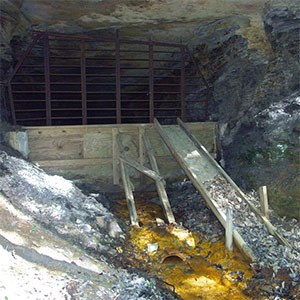
NPS photo
The National Park Service (NPS) Southeast Region (SER) Abandoned Mineral Lands (AML) Inventory and Assessment fieldwork and preliminary reporting concluded in June 2012. A total of seven parks were inventoried under contract during this initiative, with park-specific reports being developed as a final deliverable in addition to being included in the Servicewide AML database. Additional SER parks submitted their respective data to the database, collected by park personnel. This information will serve as the foundation for most future AML efforts and funding opportunities. As described below, much work remains to be done.
The primary SER AML concerns are associated with legacy coal underground and surface mines in the northern portion of the region, and oil and gas wells throughout the region. Other commodities such as phosphate and industrial limestone were mined throughout the SER. Metals were also mined in what is now Great Smoky Mountain National Park.
A number of coal mine entrances were closed by backfill or installation of lightweight steel gates in the late 1980s and early 1990s in partnership with state AML Programs and the Office of Surface Mining. Many mines remained open, however, and a most of the gates corroded badly or failed totally through time due to highly acidic soils and drainage. The most concentrated effort to address AML issues in SER was under the American Recovery and Reinvestment Act of 2009 (ARRA). Funding from this and other sources was used to plug numerous oil and gas wells, and to close mine portals either permanently through backfilling with PUF, native rock, and soils, or by installation of heavy acid-resistant steel batgates, thereby enhancing visitor safety and protecting park resources.
The top three priorities for future activities in SER are to 1) protect the public by mitigating imminent threats posed by AML features 2) complete all NEPA requirements to implement mitigation plans, and 3) perform mitigations as identified through field study and the NEPA process to protect park resources. The greatest threats to park resources in SER are contaminated mine drainage in coal country, communication between groundwater, surface water, and liquid mineral-bearing zones in orphaned wells, and erosion associated with severely disturbed lands. These issues must be addressed while precluding the possibility of spreading White Nose Syndrome which is destroying bat populations throughout the eastern US, protecting threatened and endangered species as well other sensitive species living in close proximity to AMLs, and preserving the culture of past mining activity that was largely responsible for the initial settlement of the entire region.
The continued partnering with other Federal Agencies, State and Local authorities, and support organizations such as Bat Conservation International and Friends of the Parks are key to achieving the desired outcome.. Cooperation between all stakeholders will facilitate rehabilitation of AML in the most economical and effective manner. Additional funding, technical support from experts within and outside the NPS, and public cooperation remain as SERs greatest need to restore these lands.
Last updated: February 8, 2016
